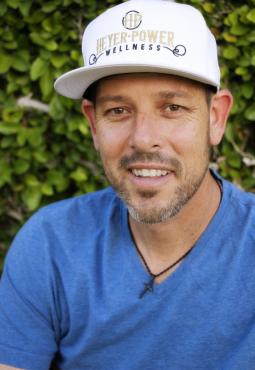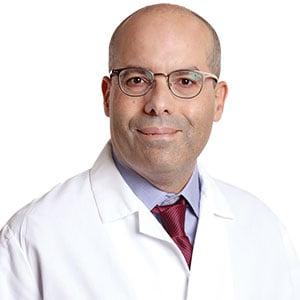Gary Heyer’s story is not a tale for the dinner table — but sharing it could help save other lives, so he retells it as politely as possible.
“If I’d flushed the toilet that night, I wouldn’t be here talking to you now,” he said.
A few years ago, Heyer went to the bathroom late one night to urinate. His wife was asleep in the next room, so, not wanting to wake her, he didn’t flush. The next morning, she was alarmed to see blood in the bowl.
Heyer hadn’t noticed the blood, and would never have seen it on his own, because he is colorblind.

“Colorblindness had been a thorn in the side for my entire life. As a kid, my clothes never matched and my artwork in school was all wrong,” he said. “Then as an adult, when you go to a party, you’re like the Sideshow Bob guy, and everyone plays, 'Hey, what color is this, Gary?’”
This time, his colorblindness almost killed him. Heyer had no idea how long blood had been present in his urine and stool.
He went straight to his family physician, and when nothing unusual appeared on a battery of tests, the doctor thought it might be fissures or colitis. To be safe, though, Heyer’s doctor recommended a colonoscopy.
An Unexpected Diagnosis
Three days before Christmas 2017, Heyer was diagnosed with Stage 4 colorectal cancer that had metastasized to his liver.
“The radiologist told me I probably had a couple of months to live,” he recalled. “It was crushing. I was so scared. My wife was so scared. It was a really dark place to be in. And we had no idea what to do.”
After exploring treatment center possibilities and getting recommendations from friends and family, Heyer decided on City of Hope, where he saw medical oncologist Marwan G. Fakih, M.D., the Judy & Bernard Briskin Distinguished Director of Clinical Research.
“It was the greatest decision I ever made,” Heyer said. “Dr. Fakih told me, ‘You can beat this,’ and he completely changed my perspective. It was no longer this huge, impossible battle. He had a game plan, and we would check my progress as we went along.”
After the first round of chemotherapy, there was good news — a little bit of reduction in the size of the tumors. A small step, but a win. Next was radiation treatment, after which Heyer underwent surgery. It took 11 hours for a team of surgeons to remove his colon, rectum, gallbladder, part of his liver and all of the involved lymph nodes.

The operation was a success, and Heyer went into remission in fall 2018.
Since then, Heyer’s cancer has recurred a few times, but regular testing and treatment are keeping it under control.
A New Outlook on Health
Despite all he’s been through, Heyer still has the contagious energy of a coach or cheerleader.
“My cancer is the greatest blessing that's ever happened to me,” he said.
After he was diagnosed, Heyer began to wonder about the root cause of his cancer. While he hadn’t had any symptoms that he noticed, he realized he hadn’t felt all that great for a long time.
“I was out of shape, overweight and full of bad habits,” he said. “I was eating all the wrong stuff and drinking all the wrong things. Instead of fueling my body, I was treating it like a garbage truck, and it was just crushing me.”
On top of that, there was the toxicity of chemotherapy to worry about. He had a friend who’d gone through chemo with very few side effects — and that friend was a vegan. So Heyer began to change his diet, eliminating meat and eating lots of fresh fruits and vegetables. He even got into juicing and herbs, kept himself hydrated, started walking for exercise and began to lose weight.
One of the things that made these changes possible was his team at City of Hope. “It was comforting to know that Dr. Fakih is so well respected and has a track record with thousands of patients with the exact same disease I have, and this trust factor is what allowed me to focus on other things.”
His diet also helped minimize his side effects from treatment and inspired him to start a business that promotes a plant-based lifestyle. Today, Heyer is in the best shape he’s been in in years — even though he is now using a chemo pump to receive treatment for lung metastasis.
“I golfed 18 holes last weekend with my pump on, then drove myself to the hospital to get it off,” he said. “And that was just the start of a long, full day.”
But what keeps Heyer motivated more than anything is his family. He and his high school sweetheart — now his wife of 17 years — have a 14-year-old daughter.
“I want to be able to walk my daughter down the aisle if she gets married and be here to be a grandparent,” he said.
Knowing When to Get Screened
Heyer’s zest for life — and his success under the most difficult circumstances — is inspiring. It’s also a warning about a danger that is not yet widely known.
The link between colorblindness and late-stage diagnosis of cancer has been explored in several respected medical publications, including the Journal of the American Medical Association — yet most people are still unaware of the potential danger.
It’s one reason why it’s important to let your doctor know if you suffer from colorblindness, especially if it prohibits you from distinguishing the color of blood. And even if you don’t suffer from colorblindness, it’s equally important to talk to your physician about a family history of the disease and to ask about testing and screening recommendations.
Over the last several years, colorectal cancer cases have risen dramatically in people younger than 50, causing the U.S. Preventive Services Task Force to revise the screening recommendations for colorectal cancer to begin screening at age 45.
Heyer was just 41 when he was diagnosed. Actor Chadwick Boseman was 42 when he lost his life to the disease. These stories and many others highlight the need for continued research and awareness around screening guidelines and the disease itself.
